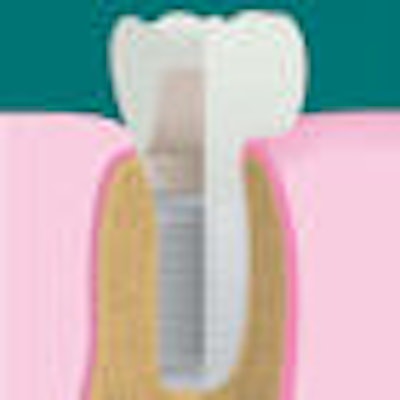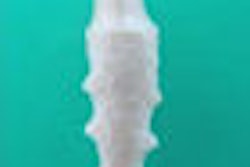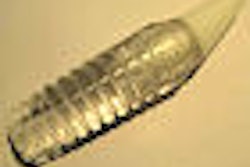
Two new studies on all-zirconia implants show these devices approaching -- but perhaps not yet attaining -- the durability of titanium.
Researchers from University Clinics Freiburg will present data on the durability of one-piece, alumina-toughened zirconia (ATZ) implants (Ziraldent, Metoxit) in 20 patients at the International Association for Dental Research' (IADR) annual meeting this week in Barcelona, Spain. This is among the first studies with clinical data on one-piece zirconia implants.
The study, which was funded by the implant's manufacturer, indicated the implant has a one-year survival rate of 88.9%.
By contrast, reviewing the literature in 2004, the ADA Council on Scientific Affairs reported that single-tooth implants had a mean survival rate of 96.7% (Journal of the American Dental Association, January 2004, Vol. 135:1, pp. 92-97).
For the IADR study, 20 patients each received one implant for single-tooth reconstruction. The implants were immediately temporized after insertion, and those that survived for at least four to eight months were permanently restored.
Two of the 20 patients were lost to follow-up. Of the remaining 18 individuals, two lost the implant due to nonintegration: one within three weeks of implantation and the other within four weeks. Among the 16 surviving implants, no fractures occurred. The investigators found that the average marginal bone remodeling during the year after implant placement was 0.88 mm. During the same time frame, two of the patients lost more than 2 mm of bone surrounding their implants.
Rough or smooth?
This new study complements one published earlier this year on the five-year success rate of consecutively placed one-piece zirconia implants with three different types of rough surfaces (Cera Crown 11, 12, 14, 16, and 21, Oral Iceberg; International Journal of Oral & Maxillofacial Implants, March-April 2010, Vol. 25:2, pp. 336-344). The study authors are principals in Oral Iceberg.
A total of 831 implants were placed in 387 patients who had a mean age of 48 years. Of these, 162 implants were placed in combination with a bone graft, and 47 were placed simultaneously with a sinus elevation. During the first year of the study, patients were alternately assigned to either a coated or uncoated surface for their implants. The new acid-etched surface then was developed and included in the study.
The overall implant success rate after five years was 95%. Broken out according to surface type, the survival rates were 92.77% for uncoated implants, 93.57% for coated implants and 97.6% for acid-etched implants. None of the implants fractured, and the researchers found no significant differences in survival rate between screwed-in (Cera Crown 11, 12, 16, and 21) and tapped-in (Cera Crown 14) implants.
The investigators hypothesized that the greater roughness of the acid-etched implants may underlie their significantly longer survival.
However, Jack Lemons, Ph.D., a professor of prosthodontics at the University of Alabama at Birmingham (UAB), has evidence that increased roughness may in fact lead to significant deterioration of some implants over time.
He and his colleagues examined the changes in surface structure and mechanical properties of toughened (tetragonal zirconia polycrystal [TZP]) femoral-head orthopedic implants after five years of in vivo articulation (Journal of Biomedical Materials Research Part B: Applied Biomaterials, May 2007, Vol. 81B:2, pp. 486-492). TZP is used in several zirconia dental implants, including the only one that has received U.S. FDA clearance: the Z-Look3 (Z-Systems USA).
The team found significant roughening of the femoral-head implant surface after five years. This resulted in reduced hardness and loss of material at the nonzirconia, articulating surface of the implants.
Dr. Lemons said his group is now evaluating the ATZ material in dental systems, and also plans to expand their retrieval and analysis of zirconia dental implants to determine if the orthopedic-implant data apply to dental implants.
"Our central concern is the surface roughening and altered biomechanical properties we found with the orthopedic implants -- which might not be an issue during the first years of clinical applications but may become an issue over time," he told DrBicuspid.com. "I don't want to raise unnecessary concerns about this material, but there is a need to extend existing studies so that we retain the high success ratios of dental-implant-based treatments."
Simpler to restore
Most titanium implants have higher success rates than those demonstrated by the one-piece zirconia implants, noted Kim Gowey, D.D.S., former president of the American Academy of Implant Dentistry. Dr. Gowey has been using zirconia abutments made by Nobel Biocare (NobelProcera abutment titanium) for about two years. He doesn't see significant advantages in the one-piece all-zirconia implants.
"Two-piece implants are simpler to restore compared to a one-piece implant if the abutment needs to be angled," he said. "The one-piece zirconia implants may be suitable for a few select cases with thin biotype tissue where the gray titanium implant body shows through the tissue and produces a gray area compared to adjacent tooth roots. But if this is only a concern above bone, then the zirconia abutments that are available for titanium bodies solve that problem."
Copyright © 2010 DrBicuspid.com



















